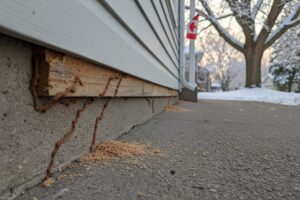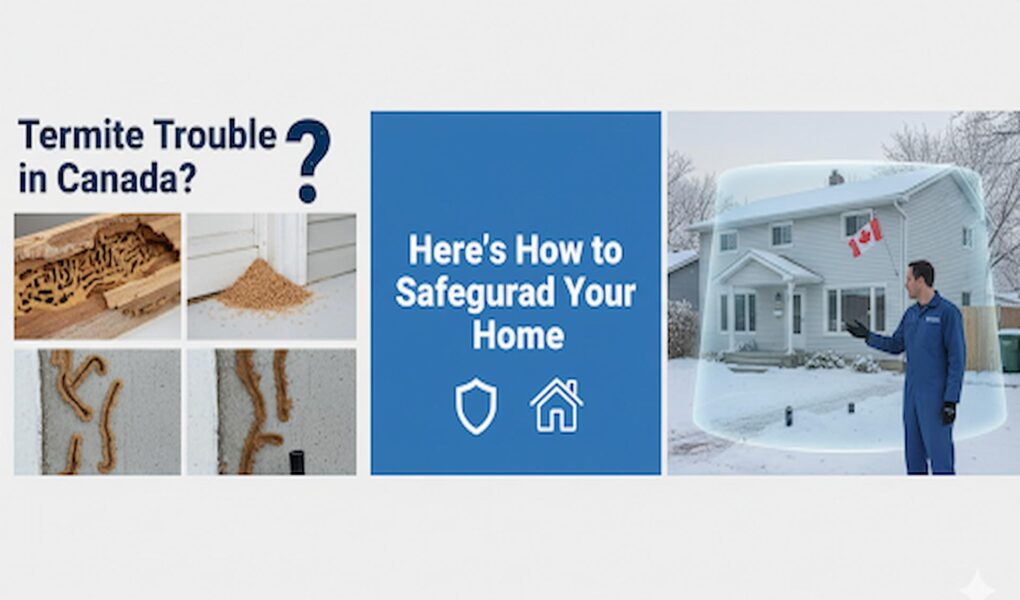Understanding the Growing Termite Threat in Canada
Termites have become a rising concern in several parts of Canada. Regions that once had low activity now report steady growth in termite colonies. Warmer winters and increased moisture have helped these insects survive in areas that were once too cold for them. Cities such as Toronto, Windsor, Hamilton, Vancouver, Victoria, and parts of southern Manitoba are seeing more cases each year.
Many Canadian homeowners assume termites are a problem limited to older homes or tropical climates. This misconception often leads to delayed action. Termites work quietly and rarely leave obvious signs at first. A mature colony can feed on floor joists, wall studs, and beams for months before the damage becomes visible. Understanding the scope of the issue is the first step in protecting your home.
Why Termites Are So Destructive
Termites rely on cellulose for survival. Wood, paper, cardboard, and plant-based materials all contain cellulose, which makes homes an easy target. Subterranean termites, the most common type found in Canada, prefer damp wood near soil contact. Once they find an entry point, they build tunnels that allow them to move through a structure while staying protected from air and light.
Their feeding habits create hollow sections that weaken the structure over time. What begins as a small colony can grow into a network of thousands. Since much of a home’s framing is hidden behind walls, termite damage is easy to overlook. This is why early detection and prevention matter.
How Climate Change Influences Termite Activity
Canadian researchers have noted a link between rising temperatures and termite survival. Warmer conditions allow colonies to expand farther north and survive winters that were once too harsh. Moisture increases also create ideal breeding environments. Rainy springs, mild winters, and humid summers give termites the conditions they need to thrive.
Urban development contributes as well. Movement of lumber, firewood, and soil from infested areas can carry termites into new regions. As homes are built closer together, it becomes easier for colonies to spread. Staying aware of these environmental changes helps homeowners respond with proper prevention.
Common Termite Species Found in Canada

Identifying the species present can guide your prevention strategy.
Subterranean Termites
Subterranean termites cause the most damage in Canada. They build colonies underground and create mud tubes to access food sources. These tubes protect them from light and dry air. They prefer damp, decaying wood but will feed on sound wood once they gain access.
Dampwood Termites
Dampwood termites thrive in water-damaged wood. They are more common along the West Coast, where moisture levels are higher. They do not require soil contact but need consistent moisture to survive.
Drywood Termites
Drywood termites are uncommon in Canada but can appear in imported furniture or wooden items. Unlike subterranean termites, they can establish colonies entirely within dry wood.
Signs of Termite Activity to Watch For
Early detection helps reduce long-term costs. While termites are discreet, there are warning signs you can spot with careful inspection.
Discarded Wings
Termites shed their wings after swarming. Small piles of wings near windows, doors, or vents often signal active colonies.
Mud Tubes
Subterranean termites build pencil-sized tubes along foundations, crawl spaces, or basement walls. These tunnels protect them while they move between their nest and food source.
Wood Damage
Wood that appears blistered or sounds hollow when tapped should be checked. Termites eat from the inside out, leaving a thin surface layer.
Stuck Doors or Windows
Moisture buildup caused by termites can make wooden frames swell. This results in difficulty opening or closing.
Small Droppings
Drywood termites leave tiny pellet-like droppings. While rare in Canada, any unexplained debris near wood should be inspected.
How to Reduce the Risk of a Termite Infestation
Preventive measures are essential for protecting your home. These steps help limit moisture, remove access points, and reduce the chance of attracting termites.
Maintain Proper Drainage
Moist soil attracts termites. Keep gutters clean and direct water away from foundations. Downspouts should carry water at least two meters from the home.
Fix Leaks Quickly
Water-damaged areas provide the moisture termites need. Inspect basements, crawl spaces, and under sinks for plumbing issues.
Reduce Wood-to-Soil Contact
Decks, porch steps, and wooden siding should not touch the soil. Concrete barriers help reduce risk.
Store Firewood Away From the House
Firewood stacked against the home can invite termites. Store it several meters away and keep it elevated.
Keep Mulch Under Control
Mulch traps moisture. Keep a gap between mulch beds and the foundation.
Seal Entry Points
Cracks in the foundation, gaps around pipes, and damaged vents can become entry points. Sealing them reduces access.
When to Consider a Professional Inspection
A yearly inspection provides peace of mind. While homeowners can spot basic signs, trained specialists use tools such as moisture meters and thermal imaging to detect early infestation. Professionals know where termites tend to hide and can confirm whether an issue is active or historical.
Homeowners searching for reliable help often look for services related to termite pest control Canada, especially when they need accurate identification and targeted treatment. Professional support becomes even more important for homes near high-risk zones or older neighborhoods known for past activity.
Treatment Options for Termite Control in Canada
If termites are found, treatment should begin right away. Several strategies are used depending on colony size and location.
Liquid Soil Treatments
These treatments create a protective barrier around the home. Termiticides are applied to soil near the foundation. When termites come into contact with the treated soil, they carry it back to the colony.
Bait Systems
Bait stations are placed around the property. Termites feed on the bait and bring it to the colony, which helps eliminate the population. This method is common for termite pest control Canada services because it is low impact and effective.
Wood Treatments
Wood can be treated with borate sprays or injected with foam products. These treatments protect vulnerable areas such as crawl spaces, joists, and basement frames.
Spot Treatments
Localized treatments target specific areas where activity is detected. This approach helps address smaller or early infestations.
How Homeowners Can Support Long Term Prevention
After treatment, prevention remains important. Even if the colony is removed, new termites may attempt to enter.
Monitor High Risk Areas
Check basements, foundations, and crawl spaces every few months. Look for mud tubes or changes in wood condition.
Maintain Ventilation
Ensure air can circulate in attics and crawl spaces. Good airflow reduces moisture buildup.
Trim Vegetation
Plants touching exterior walls can create moisture pockets and hiding spots.
Schedule Regular Inspections
Professional monitoring keeps your home protected and allows early treatment if termites return.
Why Professional Help Matters
Working with experts ensures fast and accurate action. Termite identification can be complex, and improper treatment allows colonies to spread. A qualified company offering termite pest control Canada can tailor solutions based on your region, climate, and home structure.
Professionals also help educate homeowners about risk factors and preventive maintenance. This guidance lowers the chance of recurring problems and keeps your home structurally sound.
Final Thoughts
Termites are steadily becoming a larger concern in several Canadian regions. Their ability to cause quiet and extensive damage makes prevention and early detection essential for every homeowner. By understanding the signs, maintaining your property, and taking action when needed, you can greatly reduce your risk.
Professional support is often the safest way to identify and treat termite problems. Whether you live in a high risk zone or simply want peace of mind, exploring termite pest control Canada services can help protect one of your most valuable investments. Staying informed and proactive is the best way to safeguard your home from long term damage.




